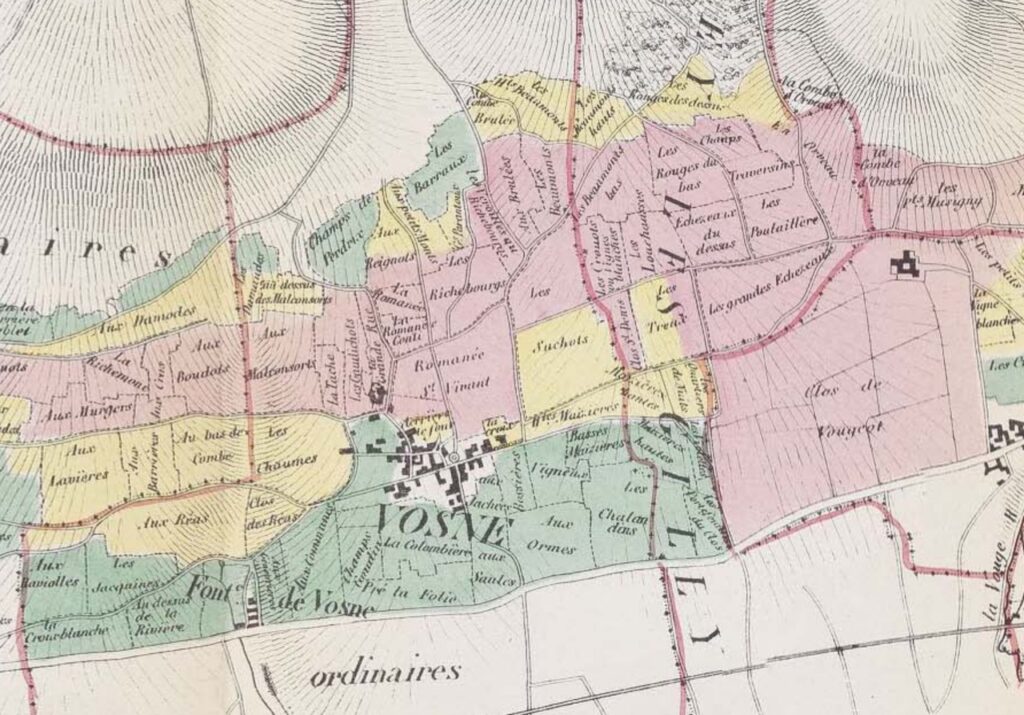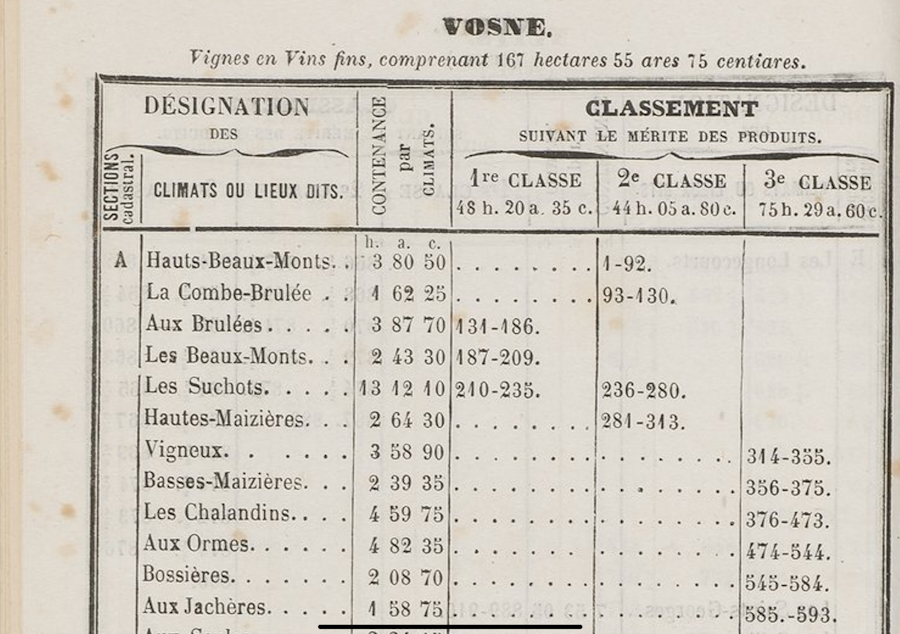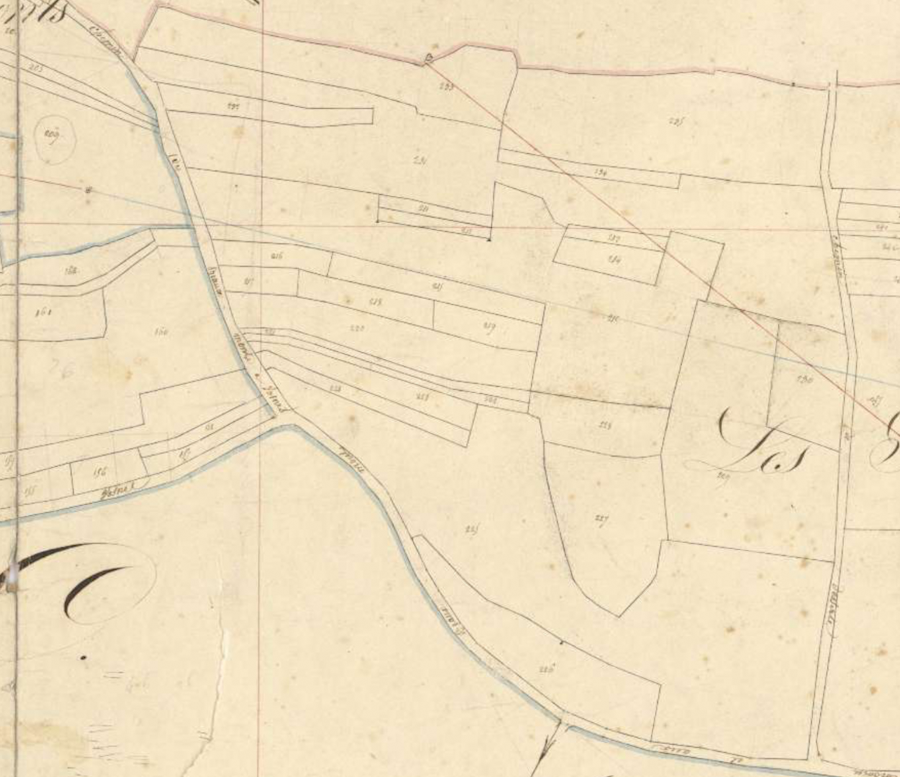One of the largest and most challenging 1ers crus is Vosne-Romanée Les Suchots. Wine from this vineyard is produced by more than 100 domaines and negociants.
Les Suchots is quite a diverse vineyard, with some areas showing great complexity while others have fewer of the qualities of a great terroir. Add to this producers that range from some of the top estates in Vosne to some of the worst, and you have wines that are diverse, normally attractive, but rarely extremely complex.
So from great to awful in one vineyard. Perhaps I’m overstating things a bit, but there is a very wide range of wines from this big 1er cru.
Let’s take a closer look!
A select history
In general, history and old maps can be used to show almost anything. Thus it is the choice of the historical documentation that will in the end give the result.
It is, however, my firm view that the complexity of Suchots is greater at the top of the vineyard than in the lower part. This is supported by the 1861 map and classification done by Batault-Morot1.


Looking at the cadastral map from 1827, we see that the plots 210-235 represent the whole upper part of Suchots, considered the best part in the table above. (Please note that there is no direct correspondence between the cadastre numbers in the table above and the map below.)

In my view, the bottom part of Suchots is better than its reputation, although the dip in the middle of the vineyard (bas) is perhaps not the best part. In the end, very good wines are made from the bottom part. They have proper 1er-cru intensity at best, but sometimes lack the complexity of the very best like Beaux Monts, Petits Monts (bottom part), or Malconsorts.
The top part, towards Beaux Monts, is the most complex, with more vivid minerality and airiness coming from lighter soil, and more natural structure. These wines don’t match the big grands crus, but the best examples can equal a good Echezeaux.
So the vines’ location in Suchots not only says something about the wine (rich or mineral-driven), but also indicates something about its ultimate potential.
The owners of Suchots
Let’s look at the plots and owners currently (2022). Some of them are well-known; others less so (like Confuron-Cotetidot, the largest owner in the vineyard).
- Domaine Confuron-Cotetidot
- Domaine Michel Noëllat
- Domaine Prieuré-Roch
- Domaine René Chacheaux et Fils
- Domaine de l’Arlot
- Domaine du Comte Liger-Belair
- Domaine Arnoux-Lachaux
- Domaine Hudelot-Noëllat
- Domaine Chantal Lescure
- Domaine Richard Maniere
- Domaine Boigey Freres
- Domaine Michel Joannet
- Domaine Gérard Mugneret
- Domaine Jérôme Chezeaux
- Domaine Yves Chevalier
- Domaine Jean-Marc Millot
- Domaine du Clos des Poulettes
- Domaine Mongeard-Mugneret
- Domaine Berthaut-Gerbet
- Domaine de Bellene
- Domaine Jean Grivot
- Domaine Sylvain Cathiard
The owners are distributed all over the 13.0760-hectare vineyard. Some producers only have one plot, others have more than one, occasionally in both sections of the vineyard.
The gray zone between domaine and negociant
It’s worth mentioning that certain producers sell grapes or wine to negociants – some almost the entire production, others only part. This means that in reality, one finds Vosne Suchots from other producers than the ones listed above.
Negociant sales are often guesswork. But producers like Domaine Yves Chevalier sell off most of its fruit these days, while Domaine Boigey is gradually selling less in order to expand its own production.
The top section of Les Suchots
The best section of Suchots has producers like Arnoux-Lachaux and Gérard Mugneret showing their talent. Charles Lachaux even produced a negociant version under his eponymous label, while making the mighty Grands Suchots under the Domaine Arnoux-Lachaux brand.
You need to login as a Premium subscriber to read the rest of this article. If you are not a Premium Subscriber, use the subscribe function and sign-up.

 - A true vin d’émotion – a Burgundy of passion
- A true vin d’émotion – a Burgundy of passion - A truly hedonistic wine – lively and enjoyable
- A truly hedonistic wine – lively and enjoyable - A vivacious wine for pure indulgance
- A vivacious wine for pure indulgance - A potential vin d´émotion - frais et léger
- A potential vin d´émotion - frais et léger
dear Steen,
congrets, great job, again! in my view, there are two questions left:
a) Does Chezeaux still have their plot or was it leased, actually from the Noirot-Maniere-Boigey-Family? If this is not the case, are there some familiy-relations between Chezeaux and the Noirots?
b) Wasn´t there a split recently concerning the plots of Confuron-Cotetidot and Confuron-Gindre? And if so, where is the plot of Confuron-Gindre located?
all the best
Kurt
will try to explore this further … thx
So excited to this article. Suchots is my favourite vineyard of all! Thanks!